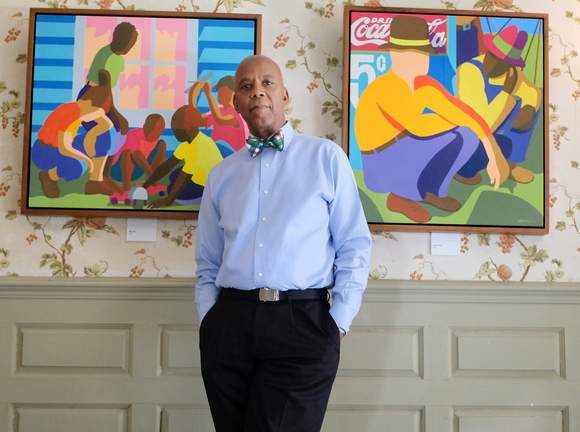
photo by Ioanna Raptis, Seacoastonline
Artist Richard Haynes has spent the last several months working in his studio at the Langdon House with Cyrus Bruce. He has come to know this long-dead gentleman, also an African American resident of Portsmouth, through creating his portrait, sharing his forgotten story through art. As these two men’s lives converge in this portrait, Haynes, the storyteller of African American lives, invites us to know more about Cyrus Bruce, the artist and ourselves.
Historic New England collaborated with the Black Heritage Trail of New Hampshire (BHTNH) for the vibrant exhibition, “A Life in Color: Two Cultural Makers, Centuries Apart,” and the Artist-in-Residence program with Haynes.
Gwendolyn L. Smith, Historic New England’s regional site manager for Northern New England, said, “The process has been truly very enriching and engaging for our many visitors. Richard Haynes brings such dynamism to everything he does, so having him as Artist-in-Residence seemed like the perfect fit. We were very fortunate to have support from the New Hampshire Charitable Foundation for the AIR program, and having Richard’s studio at the South Lodge, an original outbuilding on the Langdon house property, helped us utilize a space not normally seen by the public into an area for him to create the Cyrus Bruce portrait. Visitors from all over the country and world stopped by to chat with him while he was there weekends in August working on his portrait, and some attended an art workshop he leads, where he worked one-on-one with artists of all backgrounds teaching them his methods of using caran d’ache oil crayon to create their own works of art.”
Haynes’ experience as artist in residence at the Langdon House, creating this portrait of one of the lesser-known residents of this grand mansion, has been rewarding.
“When I was first approached by JerriAnne (Boggis, executive director of the BTNH), I thought ‘what two great institutions to work with!’ I get an opportunity to be both a cultural maker and keeper. I have the opportunity to capture the image, the portrait of an unknown man and through this, together, we are going to be cultural keepers and makers. We are going to share the black heritage, the forgotten history, through art.”
“This experience was, for me, quite meaningful. When I think about art, I think of the artist as cultural keepers and cultural makers. It has always been like that. Artists make the culture through their art, but they are also Cultural Keepers. What would we know about prehistoric people if the artists had not put the designs on the wall of caves? What would we know about the Greeks, Romans and Mayans if sociologists and archaeologists had not unearthed this work of the artists? It is amazing culturally what we find out about people in the past because of artists.”
Like Cyrus Bruce, Haynes is a Portsmouth resident, moving here permanently 29 years ago after a stint at Pease as an Air Force dental technician. He graduated with his master’s degree in photography from Pratt Institute, and photography and art was his dream, which has happily come true.
All summer he worked in his studio on a portrait of Cyrus Bruce, a free, formerly enslaved black man who was employed as a servant in the Langdon household in the late 1700s. Bruce escaped from the family that claimed ownership of him, believing his previous owner, Isaac Levy, had granted his freedom upon his death in 1777. Bruce sought refuge with British troops in New York, where he remained until he met Gov. John Langdon of Portsmouth. It is unclear where and when Bruce and Langdon met, but it is clear that Langdon was impressed. Bruce entered into a voluntary agreement Sept. 17, 1783, to work for Langdon for one year, for $6 a month, doing “any sort of business the said Langdon may require.” Bruce signed the contract with his X and was compensated in food, shelter and clothing as well as the monthly stipend.
According to oral tradition and an account of Brewster’s Rambles (1856) in the Portsmouth Freeman’s Journal, “There could scarcely be found in Portsmouth, not excepting the Governor himself, one who dressed more elegantly or exhibited a more gentlemanly appearance. His heavy gold chain and seals, his fine black or blue broadcloth coat and small clothes, his silk stocking and silver-buckled shoes, his ruffles and carefully plaited linen, are well remembered by many.” When George Washington visited Portsmouth on his tour of the country following his inauguration in 1789, Bruce would have been elegant in appearance and manners when he greeted the new country’s first President at the door of John Langdon’s mansion.

